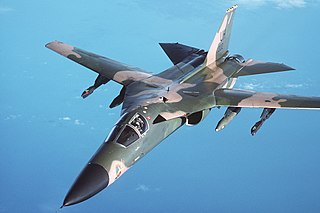 W
WThe McDonnell Douglas/General Dynamics A-12 Avenger II was a proposed American attack aircraft from McDonnell Douglas and General Dynamics. It was to be an all-weather, carrier-based stealth bomber replacement for the Grumman A-6 Intruder in the United States Navy and Marine Corps. Its Avenger II name was taken from the Grumman TBF Avenger of World War II.
 W
WThe General Dynamics–Grumman EF-111A Raven is an electronic-warfare aircraft designed to replace the EB-66 Destroyer in the United States Air Force. Its crews and maintainers often called it the "Spark-Vark", a play on the F-111's "Aardvark" nickname.
 W
WThe General Dynamics F-16 Fighting Falcon is a single-engine supersonic multirole fighter aircraft originally developed by General Dynamics for the United States Air Force (USAF). Designed as an air superiority day fighter, it evolved into a successful all-weather multirole aircraft. Over 4,600 aircraft have been built since production was approved in 1976. Although no longer being purchased by the U.S. Air Force, improved versions are being built for export customers. In 1993, General Dynamics sold its aircraft manufacturing business to the Lockheed Corporation, which in turn became part of Lockheed Martin after a 1995 merger with Martin Marietta.
 W
WThe General Dynamics F-16 VISTA is an experimental aircraft, derived from the F-16 Fighting Falcon, which was modified as a joint venture between General Dynamics and Calspan for use by the USAF.
 W
WThe General Dynamics F-16XL is a derivative of the F-16 Fighting Falcon, with a cranked-arrow delta wing. It was originally conceived as a technology demonstrator, later entered in the United States Air Force's (USAF) Enhanced Tactical Fighter (ETF) competition but lost to the F-15E Strike Eagle. Several years after the prototypes were shelved, they were turned over to NASA for additional aeronautical research. Both aircraft are currently stored at Edwards AFB.
 W
WThe General Dynamics F-111 Aardvark is a retired American supersonic, medium-range interdictor and tactical attack aircraft that also filled the roles of strategic nuclear bomber, aerial reconnaissance, and electronic-warfare aircraft in its various versions. The word "aardvark" is Afrikaans for "earth pig" and reflects the look of the long nose of the aircraft that might remind one of the nose of the aardvark. Developed in the 1960s by General Dynamics, it entered service in 1967 with the United States Air Force. The Royal Australian Air Force (RAAF) also ordered the type and began operating F-111Cs in 1973.
 W
WThe General Dynamics/Grumman F-111B is a long-range carrier-based interceptor aircraft that was planned to be a follow-on to the F-4 Phantom II for the United States Navy (USN).
 W
WThe General Dynamics F-111C is a variant of the F-111 Aardvark medium-range interdictor and tactical strike aircraft, developed by General Dynamics to meet Australian requirements. The design was based on the F-111A model but included longer wings and strengthened undercarriage. The Australian government ordered 24 F-111Cs to equip the Royal Australian Air Force (RAAF) in 1963, but the aircraft were not delivered until 1973 because of long-running technical problems. During 1979 and 1980 four of these aircraft were converted to the RF-111C reconnaissance variant. Four ex–United States Air Force (USAF) F-111As were purchased by Australia and converted to F-111C standard in 1982 to replace F-111Cs destroyed during accidents. Australia also operated 15 F-111Gs between 1993 and 2007, mainly for conversion training. The RAAF retired its remaining F-111Cs in December 2010. In Australian military and aviation circles, the F-111 Aardvark was affectionately known as the "Pig", due to its long snout and terrain-following ability.
 W
WThe General Dynamics F-111K was a planned variant of the General Dynamics F-111 Aardvark medium-range interdictor and tactical strike aircraft by General Dynamics, to meet a requirement for such an aircraft for the Royal Air Force.